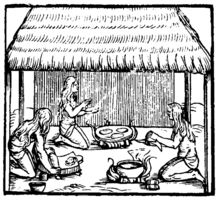
Back Gastronomia de Jamaica Catalan Jamajská kuchyně Czech Gastronomía de Jamaica Spanish Cuisine jamaïcaine French Ճամայկայի խոհանոց Armenian Cucina giamaicana Italian ジャマイカ料理 Japanese Jumiekan fuud JAM იამაიკური სამზარეულო Georgian 자메이카 요리 Korean



Jamaican cuisine includes a mixture of cooking techniques, flavours and spices influenced by Amerindian, West African, Irish, English, French, Portuguese, Spanish, Indian, Chinese and Middle Eastern people who have inhabited the island.[1][2] It is also influenced by indigenous crops, as well as, crops and livestock introduced to the island from Mesoamerica, Europe, tropical West Africa and Southeast Asia[3][4]— which are now grown locally. A wide variety of seafood, tropical fruits and meats are available.
Some Jamaican dishes are variations of cuisines brought to the island from elsewhere, which are often modified to incorporate local produce and spices. Many others are novel or Creole dishes, created from a fusion of dishes, techniques and ingredients from different cultures— which have developed locally over time. Popular Jamaican dishes include curry goat, fried dumplings, brown stew oxtail, ackee and saltfish and jerk.[1][5] Jamaican patties along with various pastries, breads and beverages are also popular.[1][5]
Jamaican cuisine has spread with migration, between the mid-17th and 20th centuries. Contingents of Jamaican merchants and labourers, who settled in coastal Latin America,[6][7][8] to establish businesses, and work in agriculture and the construction of railroads, ports and the Panama Canal,[9] contributed Jamaican dishes to the region.[10][11][12][13] Also, Jamaicans who have sought economic opportunities in other parts of the world,[14][15][16] have spread their culture and culinary practices.
- ^ a b c "Taste Jamaica". Visit Jamaica/Jamaica Tourist Board. Retrieved 2025-01-03.
- ^ "Traditional Food Preparation in Jamaica: Tools & Methods" (PDF). Jamaica Information Service (JIS). 2014. Retrieved 2025-01-03.
- ^ Francis, John Michael, ed. (2006). "Columbian Exchange—Livestock". Iberia and the Americas: Culture, Politics, and History: a Multidisciplinary Encyclopedia. ABC-CLIO. pp. 303–308. ISBN 978-1-85109-421-9.
- ^ Crosby, Alfred W. (December 2001). "The Columbian Exchange: Plants, Animals, and Disease between the Old and New Worlds". National Humanities Center.
- ^ a b "Food For The Palate; Food For The Soul: A taste of Jamaica". Visit Jamaica/Jamaica Tourist Board. Retrieved 2025-01-05.
- ^ Del olvido a la memoria: africanos y afromestizos en la historia colonial de Centroamérica (in Spanish: From Oblivion to Memory: Afromestizos in African and Central American colonial history).
- ^ Chambers, Glenn Anthony (2010). Race, Nation, and West Indian Immigration to Honduras, 1890–1940. Baton Rouge: Louisiana State University Press. ISBN 978-0-8071-3557-0.
- ^ Murchie, Anita Gregorio (1981). Imported Spices: A Study of Anglo-American Settlers in Costa Rica, 1821-1900. Ministry of Culture, Youth and Sports, Department of Publications.
- ^ "Colón Man and the Panama Experience". National Library of Jamaica Digital Collection. Retrieved 2024-12-13.
- ^ Jiménez, Patricia Vega (2025-04-29). "El Gallo Pinto Afro-Caribbean Rice and Beans Conquer the Costa Rican National Cuisine". doi:10.2752/175174412X13233545145228.
- ^ "Jamaica Observer: Colombian Ambassdor to Jamaica-More than 200 years of friendship" (PDF). Embajada de Colombia de Jamaica. 2022-08-05. Retrieved 2024-12-17.
- ^ "The Heart of Costa Rica's Afro-Caribbean Heritage Lives in Jamaica Town". 2023-12-29. Retrieved 2024-12-13.
- ^ Martin Jamieson (2011-11-24). "Culinary Caribbean English Lexicon in Panamanian Spanish". pp. 173–189. Retrieved 2024-12-13.
- ^ "Jamaica: From Diverse Beginning to Diaspora in the Developed World". 16 June 2010.
- ^ Palmer, Ransford W. (1974). "A Decade of West Indian Migration to the United States, 1962-1972: An Economic Analysis". Social and Economic Studies. 23 (4): 571–587. JSTOR 27861531.
- ^ "Farmworkers depart for Canada in 59th year of programme". Jamaica Gleaner. 2025-01-04. Retrieved 2025-01-04.